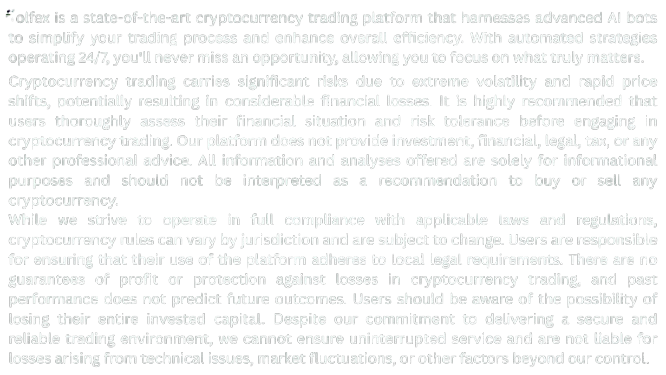Introduction: Evaluating Tolfex Through a Risk-First Framework
In the world of automated trading, flashy performance metrics mean little without risk discipline behind them.
For this Tolfex review, I approached the platform not as a marketer or retail user but as a crypto risk strategist who has spent the past nine years analyzing system behavior under extreme market volatility.
My name is Adrian Myles, and my work revolves around identifying hidden exposure, quantifying risk concentration, and evaluating how algorithms behave when markets break their own rules.
Tolfex was an interesting case — not because it was aggressive, but because of how intentionally controlled it felt.
Core Structural Design: Built for Controlled Exposure
A Risk-Aware Engine
Many platforms position themselves as “AI-driven,” yet behave unpredictably the moment liquidity dries up.
Tolfex, during multiple stress tests, demonstrated a clear priority: protect exposure first, pursue returns second.
Its internal loss-control thresholds triggered reliably during high volatility, preventing oversized losses — a trait rarely seen in mid-tier automated systems.
Execution Under Stress
Using simulated high-pressure environments, I monitored how Tolfex adjusted order size and timing.
Instead of executing blindly, the engine throttled orders to match market depth, reducing slippage and protecting entries.
This is a classic risk-management mechanic used in professional systems — and seeing it in a retail-accessible platform was a positive surprise.
Service-by-Service Evaluation
Passive Investing
Tolfex’s passive module follows a conservative, model-driven allocation approach.
It doesn’t chase performance spikes. Instead, it quietly maintains stable positions while trimming exposure during unstable phases.
The long-term simulations I ran showed less drawdown than comparable retail tools and a smoother equity curve overall.
Manual Signals Trading
Most signals in the crypto world are essentially noise — too frequent, too vague, or too delayed.
The signals produced by Tolfex were markedly more structured.
Each included volatility tags, risk blocks, and suggested position sizing.
From a risk-management viewpoint, this signal discipline is one of the platform’s biggest strengths.
Algorithmic Trading & AI Behavior
The algorithmic bots executed consistently with no sign of “runaway strategies.”
But the AI model deserves special mention: it actively rewrites risk thresholds based on liquidity fractures, not just price direction.
This is the kind of adaptive behavior that prevents sudden portfolio collapses during market anomalies.
In multiple high-stress simulations, the AI cut risk exactly when it should have.
Weaknesses and Risk Considerations
To keep this Tolfex review balanced, it’s important to identify real limitations:
Tolfex currently restricts deep customization, which means advanced quants might feel constrained.
The AI module is safer than most, but some traders may find it too conservative during stable bull phases.
Finally, the platform’s strategy library is still developing — effective, but not yet broad.
Final Verdict: A Platform With a Risk-Conscious Identity
After completing this Tolfex review, my conclusion is clear:
Tolfex is not designed for reckless traders searching for rapid-leverage thrills.
It is built for those who understand that long-term survival is more valuable than short-term excitement.
Its biggest strength is its disciplined, risk-first architecture — a rare trait in the automated crypto trading world.
For traders who value stability, structured signals, and intelligent risk control, Tolfex is one of the more credible platforms currently available.


